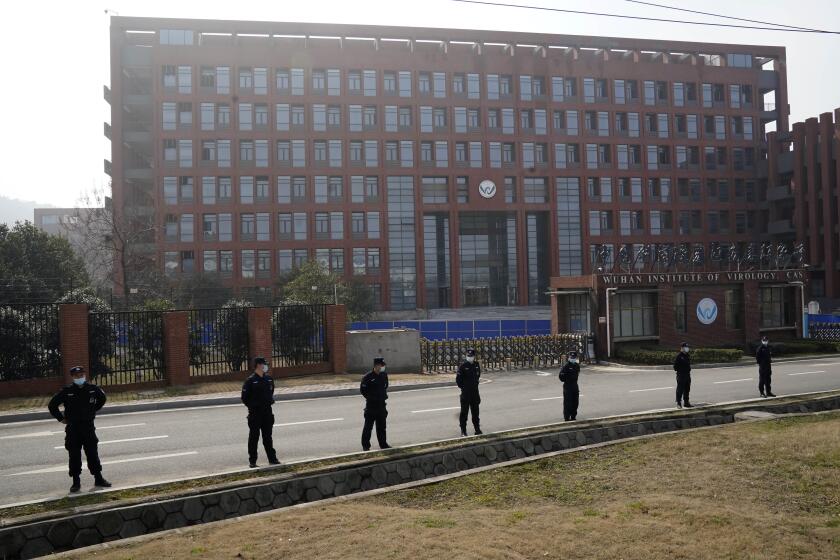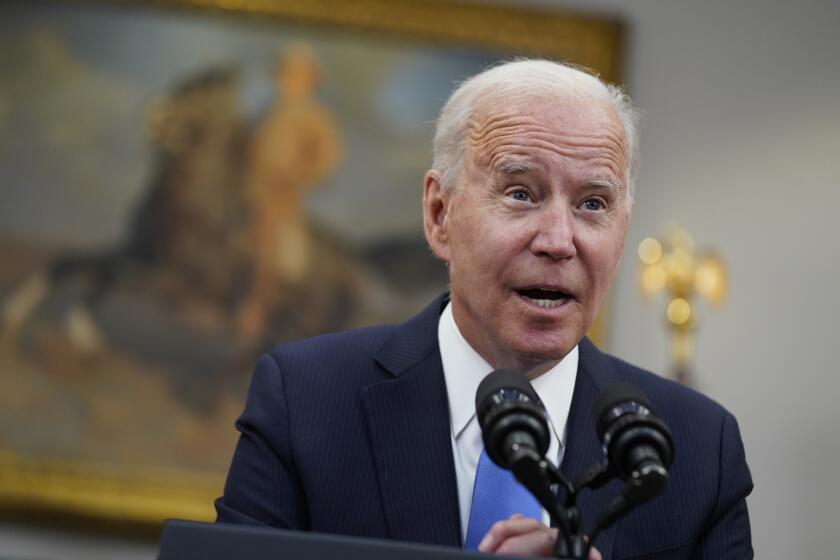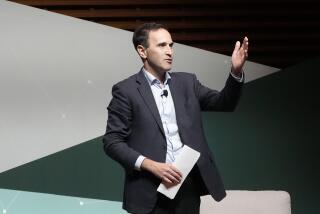Fauci: âThereâs no wayâ the coronavirus was made with U.S. research funds. Hereâs why
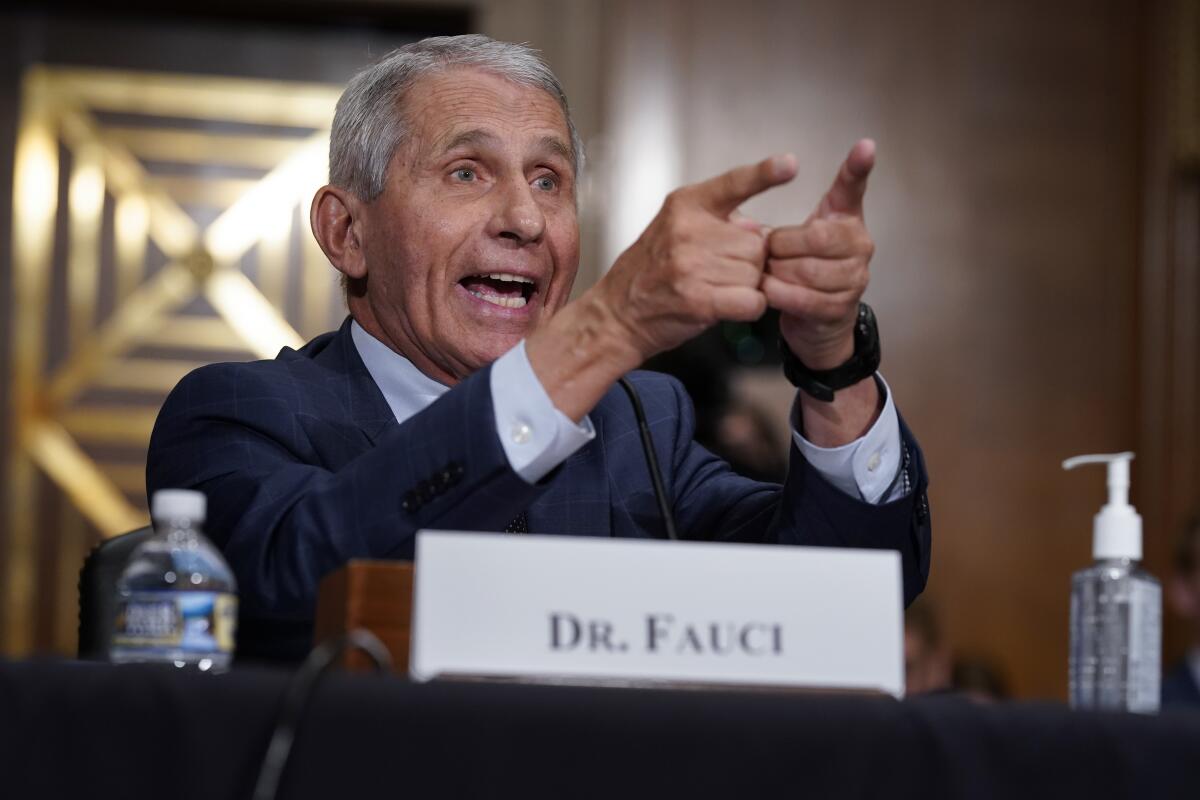
From the pandemicâs earliest days, Dr. Anthony Fauci has drawn political fire from COVID-19 skeptics. As director of the National Institute for Allergy and Infectious Diseases (NIAID), Fauci is steeped in the scientific disciplines of virology, immunology and vaccine design. But critics, especially President Trump and his political allies, continue to excoriate him for supporting textbook public health measures like wearing face coverings and building immunity with vaccines.
The latest example occurred this week on Capitol Hill, when Sen. Rand Paul (R-Ky.) effectively accused Fauci of sending U.S. tax dollars to China so scientists there could soup up coronaviruses culled from bats and make them more dangerous to people. Then he accused Fauci of lying to Congress about the purported project.
In a final shot, Paul said Fauci could be responsible for more than 4 million deaths worldwide.
Fauci has stoically endured a lot of molten rhetoric over the past 18 months, but he did not accept these charges quietly.
âSen. Paul, you do not know what youâre talking about, and I want to say that officially,â Fauci said. âI totally resent the lie you are now propagating.â

Dr. Anthony Fauci: âSenator Paul, you do not know what you are talking about, quite frankly, and I want to say that officially. You do not know what you are talking about.â
Paul told Fox News the following day that he will ask the Department of Justice to explore whether Fauci committed a felony by lying to Congress, a crime which is punishable by up to five years in prison. That would stem from Fauciâs May 11 assertion to the Senate Committee on Health, Education, Labor and Pensions that the National Institutes of Health never funded so-called gain-of-function research at the Wuhan Institute of Virology â the type of work that would give a virus new and more dangerous capabilities.
Paulâs claims rest on some very specific assumptions, not all of which have been demonstrated to be true.
In science, at least, assumptions must be verified if the conclusions that emerge from them are to be taken seriously. Due to repeated interruptions, Fauci didnât get a chance to respond to all of Paulâs charges at this weekâs hearing. Letâs consider them now and see how well they are, or could be, backed by evidence.
Assumption 1: NIAID funded gain-of-function at the Wuhan Institute of Technology.
In 2014, the institute Fauci directs awarded a five-year, $3-million grant to the New York-based EcoHealth Alliance for a project titled âUnderstanding the Risk of Bat Coronavirus Emergence.â
That project focused heavily on China, where novel coronaviruses had emerged from animals on several occasions. The work promised to explore the potential pandemic risk of such viruses by gathering samples from the field, studying viruses in the lab, and developing models about how they could evolve and spread in real life.
In an interview, Fauci said that roughly $600,000 of the grant money went to the Wuhan Institute of Virology. Scientists there â many of them U.S.-trained â were tasked with nailing down the precise origins of the original SARS-CoV-1 virus that arose in Chinaâs Guangdong Province in 2002. They were also asked to âhelp us understand what we need to look forâ to spot âwhat might be an inevitable subsequent SARS outbreak.â
That grant allowed scientists to test coronavirus samples harvested from wild animals and their habitats to see whether they were capable of infecting human cells. To do that, the WIV researchers created an experimental âbackbone,â a piece of inactivated virus that serves as a standardized testbed. Then, to examine a particular coronavirus sample, they spliced off its spike protein and fused it to the backbone before exposing it to human cells in lab dishes to see if it would grow.
Scientists are urging their colleagues to dig deeper into the origins of the coronavirus behind the pandemic, including the possibility of a lab escape.
At the time, there was a prohibition against using federal funds for gain-of-function research. That specifically barred âresearch projects that may be reasonably anticipatedâ to make influenza and SARS viruses more transmissible and/or more virulent in mammals âvia the respiratory route.â
WIVâs adherence to that prohibition was monitored, and if in the course of an experiment a virus appeared to have been made potentially dangerous, the instructions were clear: âThe experiments must stop and youâve got to report to the [NIAID] immediately,â Fauci said.
This bit involves a bit of trust. After all, some changes in transmissibility or virulence occur naturally during lab experiments, and watching for those changes is part of the point of doing them. To document when and how a virus might become capable of jumping to humans, itâs crucial to identify where genetic mutations arise, under what circumstances, and how they may change a virusâ behavior.
But observing such changes and making them are two different things. The purpose of the WIV research was to investigate coronaviruses that were known to circulate in animals (but had not been seen in humans) and to explore their capacity to invade human cells. That makes it hard to say whether the altered virusâ ability to invade human cells was a function âgainedâ or was merely uncovered by WIV scientists.
In addition, genetic tampering or editing will typically leave behind discernible marks. In a recent âcritical reviewâ of the origins of SARS-CoV-2, an international group of virologists notes that the virus âcarries no evidence of genetic markers one might expect from laboratory experiments.â
Assumption 2: Scientists funded by NIAID increased the virulence or transmissibility of the coronaviruses they sampled.
Scientists at WIV created hybrid viruses, or chimeras, when they spliced the spike proteins of actual coronaviruses onto viral testbeds â a procedure that makes it easier to isolate the effects of the spike protein, which is key to invading cells.
Two chimeras made with spike proteins from bat coronaviruses were able to infect human cells.
Paul, who has a medical degree and trained in ophthamology, said such experiments âcreate new viruses not found in nature,â which is true. The work âmatches, indeed epitomizes, the definition of gain-of-functionâ research barred by the NIH. âViruses that in nature only infect animals were manipulated in the Wuhan lab to gain the function of infecting humans,â he said.
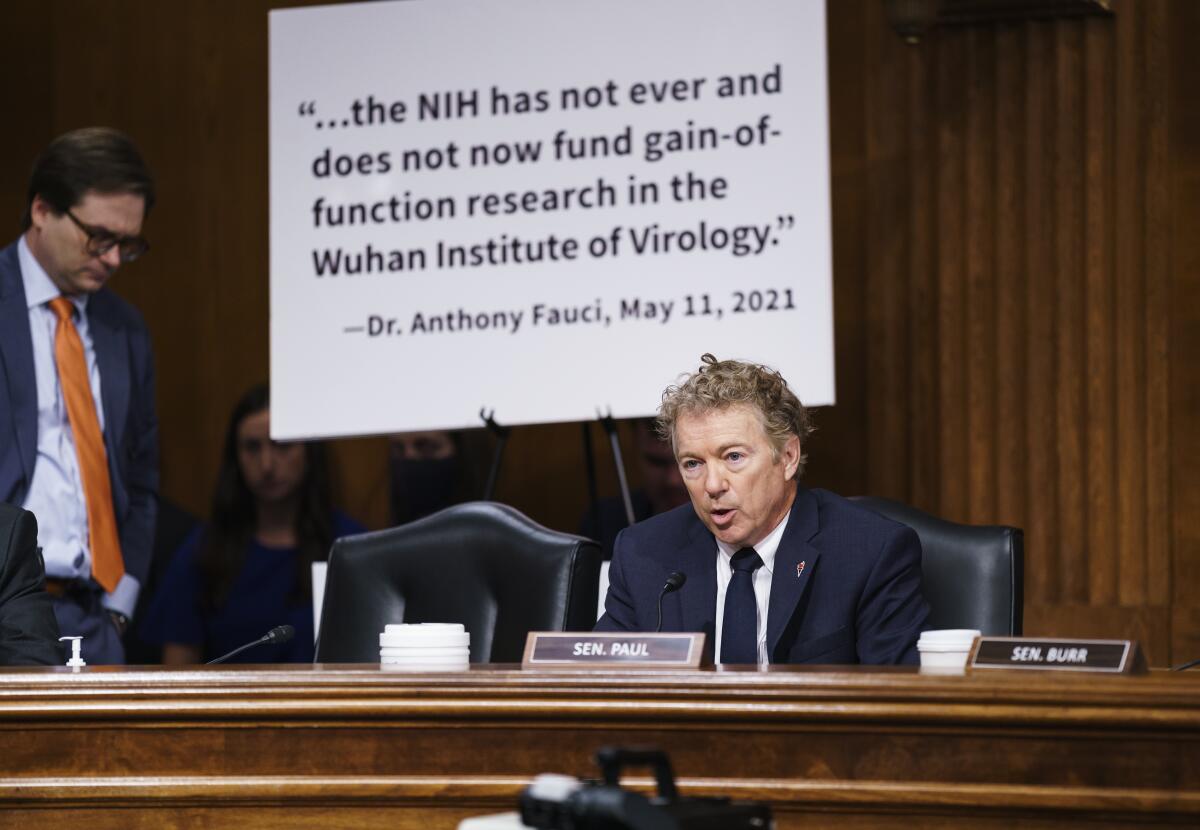
But that view is subject to debate among scientists.
Fauci said the practice of combining spike proteins from the wild with a lab-made viral backbone was standard laboratory procedure. This particular backbone was adapted from pieces of a bat virus ânever known to infect humans,â he said.
The experiments were reviewed at many levels by qualified professionals in virology, who judged that it was not gain-of-function work.
âWeâre looking at spike proteins of bat viruses that are already out there,â Fauci said. âWeâre not manipulating them to make them more or less likely to bind to human cells. Weâre just asking, âDo they, or not?ââ
He said the assurances he provided the Senate committee in May were similarly vetted up and down the NIH.
âNeither NIH nor NIAID have ever approved any grant that would have supported âgain-of-functionâ research on coronaviruses that would have increased their transmissibility or lethality for humans,â NIH Director Francis Collins said in a statement issued on May 19.
One thing is clear: Federal scientists now have broad latitude to define whether a line of research could result in an âenhanced potential pandemic pathogen.â A 2017 document from the U.S. Department of Health and Human Services allows the NIH to proceed if expert reviewers determine that it is âscientifically sound,â the pathogen that could be created âis a credible source of a potential future human pandemic,â and the investigator and his or her institution âhave a demonstrated capacity and commitment to conduct [the research] safely and securely.â
Assumption 3: The coronavirus chimeras escaped the WIV lab, either accidentally or deliberately.
Whether SARS-CoV-2 emerged from the Wuhan lab is the subject of ongoing debate and investigation by scientists and the U.S. intelligence community. While the World Health Organization initially judged the prospect of a lab leak âextremely unlikely,â the organizationâs director general, Tedros Adhanom Ghebreyesus, has since said that âall hypotheses remain on the table.â
President Biden has given the intelligence community until late August to conduct a review of the facts and âbring us closer to a definitive conclusionâ about which of two scenarios â a laboratory accident or human contact with an infected animal â began the chain of events that led to the pandemic.
Fauci rules out only one scenario: that the viruses examined under the NIAID contract initiated the pandemic.
Assumption 4: Viruses that were altered in the Wuhan lab with NIAID funds seeded the pandemic.
This is the leap of logic that Fauci, in an interview, called âabsolutely inflammatoryâ and âslanderous.â It is also the claim that is most difficult to support with evidence.
âIs it conceivable that somewhere in the Wuhan institute they were looking at viruses that may have leaked out? Iâm leaving that to the people who are doing the investigation to figure out,â Fauci said.
But there is âone thing that we are sure of,â he added: âThe grant that we funded, and the result of that grant â given in the annual reports, given in the peer-reviewed literature â is not SARS-CoV-2.â
U.S. intelligence agencies are investigating the origins of the COVID-19 pandemic, including the possibility that they lead to a Chinese lab.
How can he be so sure? There is just too much evolutionary distance between the coronavirus samples the Wuhan scientists were working with â all of them genetically sequenced and detailed in published work â and the virus that causes COVID-19.
This is what Fauci meant when he told lawmakers this week that it was âmolecularly impossibleâ for the viruses examined by WIV to evolve into SARS-CoV-2: Generally, the overlap between the genomes of the viruses in the lab and that of SARS-CoV-2 was no more than 80%.
In evolutionary terms, thatâs a chasm. In their critical review, the international group of virologists note that SARS-CoV-2 and its closest known relatives have an overlap of about 96%. That âequates to decades of evolutionary divergence,â they wrote.
Given that, Fauci said, âthereâs no wayâ the viruses studied at WIV could have evolved into the virus that has caused 4 million deaths around the world.
Would it be possible to bridge that gap with some deft splicing and dicing in a lab? Perhaps, but if so, telltale marks likely would have been left behind. Those have not been seen by scientists who went looking.
Those same scientists have noted that, were someone looking to make a coronavirus as transmissible as possible, he or she would have changed the spike protein in ways that were already known to improve the virusâ ability to spread.
